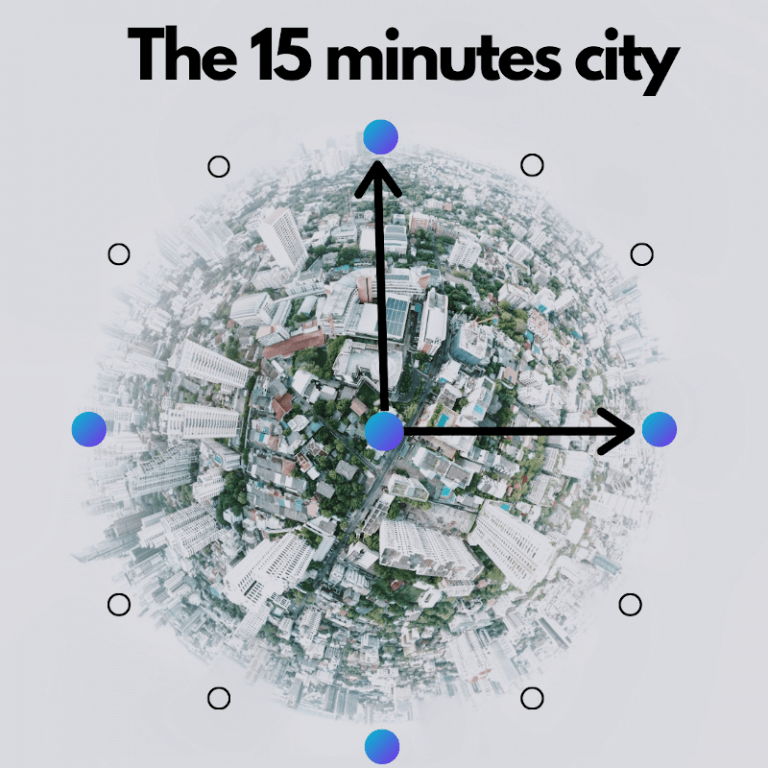We are witnessing the dawn of a profound change in the way that communities live and work. The realization of the 15-Minute Commute could be one of the most dramatic and long-lasting legacies of the pandemic.
Research shows that in major cities around the world, you’re likely to be sitting on a bus or train for between 45 minutes and an hour on your way to and from work each day. However a radical new town planning philosophy known as the ‘15-Minute City’ is coming up.
Why are we talking about the topic on our blog? For several reasons:
- Sustainability is a key value in our community. We implement eco-friendly measures in our coworking spaces (recycling, renewables electricity providers, etc.) and we are up to day and always up on topics that can help our planet. And the 15-minute city is one of them.
- Los flexible workspaces play a key role in such transformation, they provide a solution to workers and companies for a well-fit workspace nearby their living area, to combine with needed commutes to the HQ.
- Valencia has optimal conditions to make the fifteen minute dream come true. Valencia, due to the size, allows to move around in quite a short time; its orography and flat terrain, facilitates the commute both walking or cycling; its urban distribution, the old Turia riverbed that connects East to West, and the beach promenade, are all natural roadway and urban connection for people.
What is a 15-Minute City?
The 15-Minute City theory was devised by Professor Carlos Moreno of the Sorbonne. Put simply, a 15-Minute City is a place where everything a resident needs – not only from your place of work but also from all the services and leisure venues you need on a weekly basis – can be reached within a quarter of an hour on foot or by bike.
One of the earliest champions of Moreno’s concept was Anne Hidalgo, mayor of Paris. In her successful 2020 election campaign, she adopted the 15-Minute City as a core policy. Moreno’s vision is that thanks to a more localized life, the people of Paris will enjoy better work-life balance, connect more deeply with their communities and help to cut carbon emissions.
Now the environmentally friendly, sustainable, health-enhancing 15-Minute City concept is increasingly finding support worldwide, with cities including Milan, Edinburgh, Seattle and Madrid all working on developing the idea for a smarter post-pandemic future. “As cities work towards Covid-19 recovery, the 15-Minute City is more relevant than ever as an organising principle for urban development” says C40, a network of nearly 100 mayors from megacities around the world.
Work where you live
Pre-pandemic, the lack of affordable housing close to many workplaces presented a challenge to the concept of the 15-Minute City. In the wake of Covid-19, though, the rise of the hybrid working model has seen more and more companies realize that there’s a third option, one beyond simply working from home or basing staff in a central office: flexible workspaces.
The ‘hub-and-spoke’ model allows workers the flexibility to attend collaborative, face-to-face meetings at a company HQ, but also to base themselves in a flexible workspace closer to home when working solo. This way of working will be crucial in helping to establish the world of the 15-Minute Commute.
Bringing the concept to life
Not only Paris; in the USA, cities such as Portland, Oregon, and Austin, Texas, are both embracing the 15-Minute City lifestyle. Large firms are setting up workspaces in suburban locations instead of city centres, enabling people to work closer to where they live.
In the UK, Brighton is a great example of the concept’s success. Popular residential areas of the seaside city are all within a short walk or cycle ride of the city’s main shopping areas, amenities and entertainment venues, as well as the beach and the South Downs National Park.
Copenhagen, Berlin, Madrid and Milan are also thought of as ‘hotspots’ for the realisation of the 15-Minute City, as is Melbourne in Australia. And Valencia? As well.
Realistic?
Though the “quarter-hour” framework seems convenient and ecologically sound, it implies many limitations. Lockdown challenged an understanding of cities as places that provide the chance introductions and chains of encounters upon which interesting careers (and personal lives) are constructed. Is it realistic to think of this 15-minute lasso as a permanent, practicable feature? “We don’t want to oblige people to stay in the 15-minute district,” Moreno says“, We don’t want to recreate a village. We want to create a better urban organisation.”
It’s about giving people the option to meet their needs within a 15-minute walk or cycle — with Covid-19 we’ve had a taste of that. It’s not that everything needs to be within 15 minutes and you’re stuck within it, but it’s trying to ensure that people don’t hop in their car everyday to get what we need. It’s not a limit, but a broadening of options. It takes away some of the unnecessary journeys and brings pollution reduction with it.
A look into the future
The 15-minute city is a place composed of people-friendly and connected neighbourhoods. It means re-engaging people with their local areas, fostering attachment to your own area of residence, and decentralising city life and services. Reducing mass commuting and contributing to a healthier planet. A future in which flexible working models and coworking spaces play a key role. A future that in Valencia we hope to see soon.


